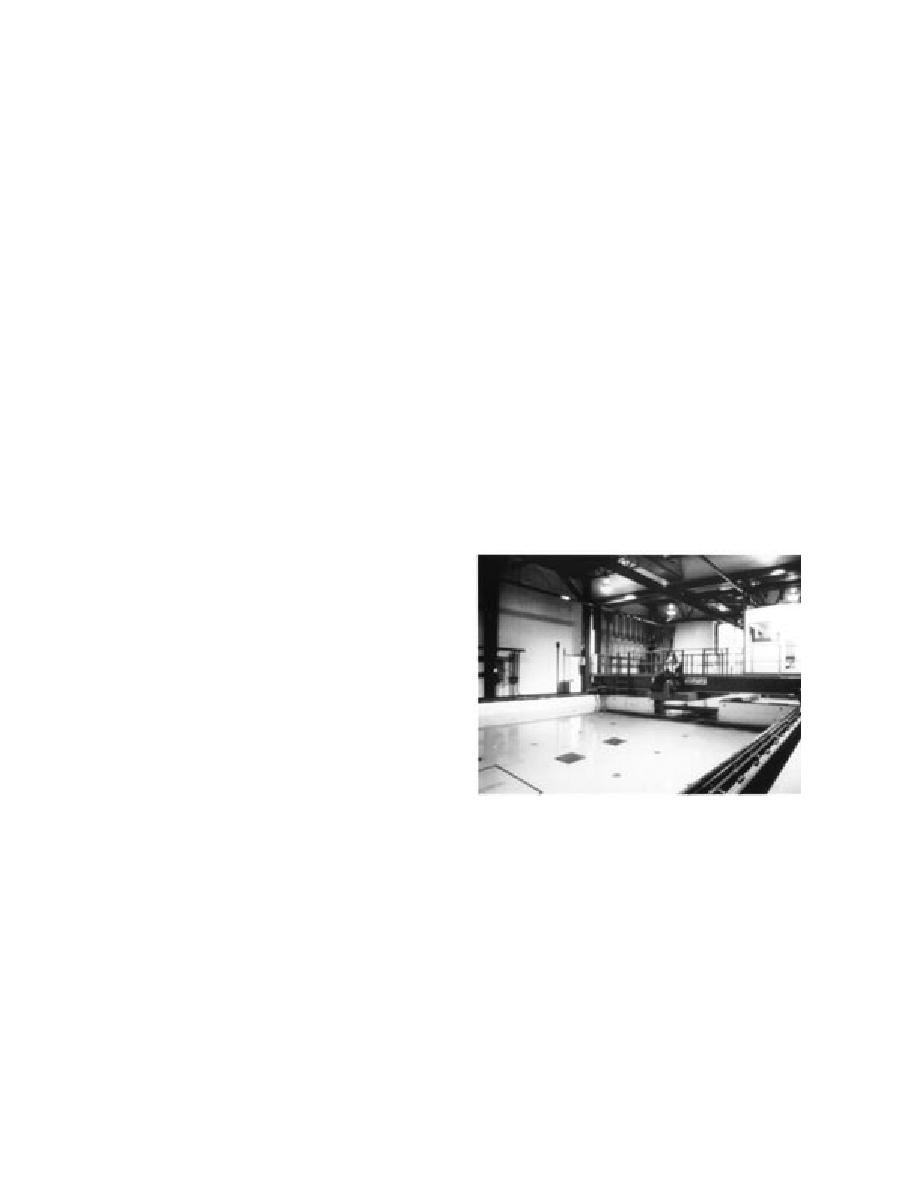
ter every test. When relatively large quantities of
ing, D100 is a better indicator of performance. We
rocks were shoved by the ice over the top of the
used four different sizes of stone in this study: a
relatively large stone size of D100 = 127 mm (5 in.),
bank into the basin during a test, we replaced the
a medium stone size of D100 = 76 mm (3 in.), and a
lost rocks with a mix of rocks that had the same
small stone size of D100 = 38 mm (1.5 in.). The thick-
gradation as that of the original mix.
ness of the riprap blanket was approximately 1.5
to 2 times the D100 stone. We determined the bulk
Ice growth procedure
rock porosity by weighing a known volume of
The test basin at CRREL is 36.6 m (120 ft) long,
rocks, and found it to be approximately 0.30 for
9.1 m (30 ft) wide, and 2.4 m (8 ft) deep (Fig. 11). It
all size distributions of rock used.
holds a solution of urea in water, 1% by weight, at
a temperature of approximately 0C (32F). To
We scaled down the distribution of stone sizes
for D100 = 127 mm (5 in.) from a recommended
grow an ice sheet, the temperature in the room is
lowered to 10C (14 F). The water is kept mixed
distribution of riprap in the U.S. Army Corps of
Engineers (1991). Approximately, the distribution
with a bubbler system to prevent ice growth dur-
of stone by weight was given in the following: 127-
ing this pull-down time. When the ambient tem-
perature in the room reaches 10C (14 F), we
mm- (5-in.-) diam. stone 15%, 102-mm- (4-in.-)
diam. stone 45%, 76-mm- (3-in.-) diam. stone 24%,
spray fresh water into the air above the water sur-
face to seed an ice sheet. During the seeding pro-
and 38 mm- (1.5-in.-) diam. stone and smaller 16%.
cess, ice crystals form in the air and fall onto the
This distribution is equivalent to D85 = 102 mm (4
surface of the water. This seeding technique re-
in.), and D15 = 38 mm (1.5 in.). The ratio D85/D15
sults in growth of small-size columnar ice crys-
= 2.7.
tals. The room is then cooled further to a temper-
The distribution of stone sizes for D100 = 76 mm
ature of 20C (4F) to proceed with the ice
(3 in.) was more uniformly graded with basically
growth.
two stone sizes in the mix. Approximately 50% by
weight of the total stone distribution was 76-mm-
(3-in.-) diam. stone and the diameter of the other
50% of the stone was 38 mm (1.5 in.) and less. The
resulting D85 = 76 mm (3 in.), and D15 = 38 mm
(1.5 in.) gave a D85/D15 ratio equal to 2.
The distribution of stone size for D100 = 38 mm
(1.5 in.) was a well-graded standard mix direct
from the plant designed to be used for grading
septic systems. The shape of this rock was slightly
blocky with angular edges. We estimated the ra-
tio D85/D15 for this mix was about 2.
Placement of model riprap
Because we did not want any rock breakage
(which was observed to occur as a result of rough
Figure 11 Refrigerated test basin in the Ice Engineer-
handling during previous small-scale tests), we
ing Facility.
distributed the larger stones evenly over the model
bank by hand as widely and evenly as possible.
Total growth time of our model ice sheets de-
Although placing the riprap by hand was a labo-
pends on the required ice thickness. Once the
rious and time-consuming process, we made ev-
thickness is achieved, the desired strength was
ery attempt to place the stone in a consistent fash-
obtained by "tempering" the ice sheet at a higher
ion for each test run. We did not dump the stones
room temperature of 0C (32 F). The ice impuri-
from a great height, nor were they keyed in by
ties (trapped between crystal platelets) weaken the
hand. Because the stone placement took consider-
ice when the ice warms slowly. The flexural
able time, we did not replace all the rock after ev-
strength of the ice is measured during the temper-
ery test, although that would have been ideal. In-
ing process until the desired strength is reached.
stead of removing and then replacing all the stone
The desired flexural strength of a model ice sheet
to ensure that the riprap was not being "wedged-
is about 87.5 kPa (12.5 psi), which is one-eighth of
in" to the bank by repeated ice shoving events,
the full-scale value of 700 kPa (100 psi). While test-
we carefully rearranged the rocks on the bank af-
9



 Previous Page
Previous Page
